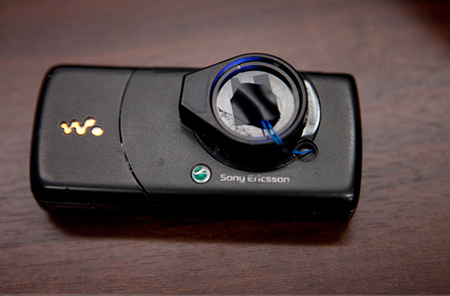Hacked cell phone blood analyzer

Lensfree Ultrawide-field Cell-monitoring Array platform based on Shadow or LUCAS for short is an amazing new hack by a researcher at UCLA. This quick little hack involving only some wire, a filter, and an LED might revolutionize blood testing. This hacked camera replaces a unit that is usually the size of a refrigerator and very expensive to run. This is a pretty amazing achievement and should serve as inspiration for hackers all everywhere.
[thanks to everyone who sent us this link]

Xbox 360 controller update

[erdbeerfetischist] sent us an update on his arcade controller for the Xbox 360 (translated). While this isn’t an amazing feat, the original was in a pizza box. We thought you would all be happy to know that he built a hard enclosure for it. We dig the transparent top too.

Flash for jailbroken iPhones

Hackers are continuing to outpace Apple with feature additions. The team at iMobileCinema has created a flash plugin for the Mobile Safari browser. It’s a beta release and still a bit buggy. This app is only available to people who have jailbroken their iPhones. You just need to add d.imobilecinema.com to your sources in Cydia to get the package to appear. While it can crash from time to time, it’s certainly better than no support at all.
[via Gizmodo]

Netbooks, slow thanks to Microsoft

[nico] pointed out something that didn’t seem to get any air-time during the recent netbook kerfuffle. Part of the original TechCrunch complaint was that netbooks are underpowered. This is a direct result of Microsoft’s Ultra Low Cost PC (ULCPC) licensing program. If manufacturer’s don’t stick to Microsoft’s restrictions, they can’t purchase XP at a discount ($26-32), which is the only way to get XP since they no longer sell it. These rules are why you can’t buy a netbook with more that 1GB of RAM.
[photo: secretlondon123]

NanoTouch, lucid touchscreen navigation

The fine folks at Mitsubishi Electric Research Labs (MERL) are demoing a new touchscreen system that may make small devices easier to use. An extension of their LucidTouch technology, NanoTouch has a small screen on the front and a touchpad on the back. Their test unit features a 2.4inch screen. The screen displays where the user’s finger is on the back touchpad as if the display was transparent. The user’s finger no longer obscures the screen surface, so it’s much easier to hit small buttons. In testing, researchers showed that targets just 1.8mm across were easy to hit. That’s much smaller than the iPhone’s touchscreen keyboard. Here’s a video demonstrating the new device.
[via Engadget]

The future of annoyance

[Garrett] posted about ThinkGeek updating the Phantom Keystroker to support random capslocking. You may remember that [Garrett] built the Stealth USB CapsLocker for April Fool’s day. The tiny device would randomly turn on the victim’s Caps Lock. This update to the commercial product has inspired him to refresh his own design. He suggests few possible options: random inserts, erratic volume control, or random sleeps. He’s also planning on making it more accessible to hacking. What would you add?

UK raid seizes 1,800 flash cartridges

South Wales Police raided a store in Cardiff seizing 1,800 Nintendo DS flash carts. The devices can be used for playing pirated games or running homebrew software. In the UK, the carts are illegal under the Trademarks and Copyright Acts. The 21-year-old suspect had imported the devices and was selling them both online and in-store. He had over 1,000 devices in his home. Many of them packed and ready to ship. Official statements by the Entertainment and Leisure Publishers Association claim that the hardware irreparably damages the DS handhelds.
[via Joystiq]

DS + 50D timelapse examples
We covered [Steve Chapman]’s Nintendo DS control for his Canon DSLR in September. He’s since improved the software so that it has a timer for sunset/sunrise amongst other things. He also shot about 30GB worth of timelapse images while in Vancouver and assembled a couple test videos. He’s still working out the processing to take full advantage of the 15megapixel images. We look forward to future results since YouTube is now using a much larger player for high def content.

You received this email because you are subscribed to the real_time feed for http://hackaday.com/feed/. To change your subscription settings, please log into RSSFWD.

No comments:
Post a Comment